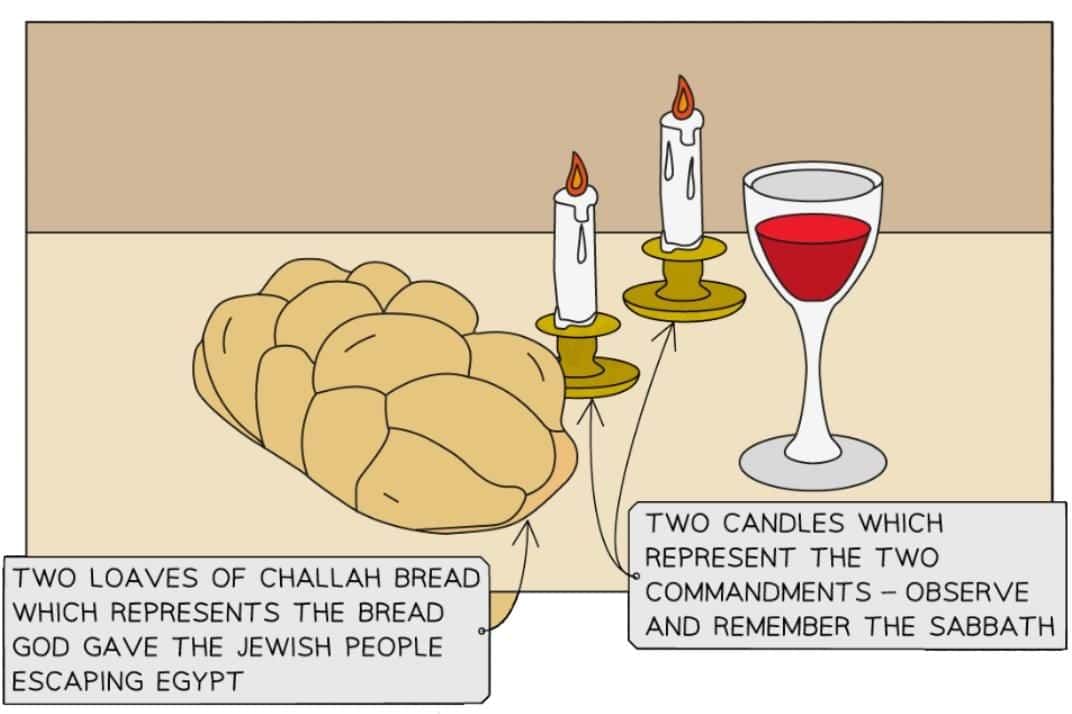Worship in the Home & Synagogue | Religion, Philosophy & Ethics for GCSE/IGCSE - Year 11 PDF Download
| Table of contents |

|
| The Significance of Prayer |

|
| Importance of Regular Prayer |

|
| Biblical Commandments on Prayer |

|
| Daily Prayers |

|
| Shabbat in the Home & Synagogue |

|
| Worship in the Home |

|
| Private Prayer |

|
| Mezuzah |

|
The Significance of Prayer
Prayer and worship are vital to Jewish faith, practiced both in synagogues and at home, even by those attending synagogue services nightly.
Importance of Regular Prayer
Jews prioritize regular prayer at home and in the synagogue to foster a strong relationship with God.
- Orientation Toward Jerusalem: When praying, Jews face Jerusalem, which in the UK is eastward.
- Structured and Unstructured Prayer: Jewish prayer can be formal or spontaneous, using set prayers or personal words.
- Personal Prayer and Reflection: Private prayer, whether using traditional texts or personal expressions, is a key aspect of Jewish life.
- Siddur (Prayer Book): The Jewish prayer book, called a siddur, contains services for home or synagogue use.
Biblical Commandments on Prayer
Several mitzvot (commandments) emphasize prayer, including:
- Deuteronomy 6:13: "Fear the Lord your God, serve him only and take your oaths in his name."
- Exodus 23:25: "Worship the Lord your God, and his blessing will be on your food and water. I will take away sickness from among you."
Daily Prayers
The Shema
Many Jews recite the Shema, a central declaration of faith, at least twice daily:
- Text: "Hear O Israel, the Lord our God, the Lord is one" (Deuteronomy 6:4).
- Purpose: Affirms belief in one God, reinforces mitzvot against worshipping other gods, and includes gratitude for meals (Deuteronomy 8:10).
Morning Prayer: Modeh Ani
The Modeh Ani is often the first prayer said upon waking:
- Belief: Sleep is likened to death, as the soul goes to God, who decides whether to return it.
- Purpose: Waking signifies God’s choice to restore the soul, and the Modeh Ani expresses gratitude for another day.
- Typical Words: "I am thankful before you, living and enduring King, for you have mercifully returned my soul within me. Great is your faithfulness."
- Practice: God’s name is avoided until hands and body are washed, out of respect.
The Amidah
The Amidah, or Standing Prayer, is central to Jewish worship, recited silently while facing Jerusalem:
- Structure:
- First 3 Blessings: Praise God and seek His mercy.
- Middle 13 Blessings: Request God’s assistance.
- Final Blessing: Offer thanks to God.
- Setting: Typically part of synagogue worship, performed standing and in silence.
Shabbat in the Home & Synagogue
Shabbat Service
Shabbat, a day of rest, reflects God’s rest on the seventh day of Creation (Genesis) and is reinforced in Exodus 31:17: "It is a sign forever that in a six-day period, God made heaven and Earth and on the seventh day he rested."
- Significance: Connects Jews to their ancestors’ liberation from slavery, symbolizing freedom through abstaining from work.
- Prohibited Activities: Jewish law forbids tasks like lighting or extinguishing fire, writing, and repairing.
- Family Focus: Jews rest and spend time with family.
Shabbat at Home
The fourth commandment (Exodus 20:8–10) mandates keeping Shabbat holy, observed from Friday sunset to Saturday sunset.
- Biblical Basis: Commemorates God’s rest after Creation.
- Preparations:
- House is cleaned, meals are prepared, and two candles are set on the dining table, symbolizing the commandments to "remember" and "observe" Shabbat.
- Two loaves of challah bread represent God’s provision of manna in the desert.

- Friday Evening Meal:
- Begins with lighting two candles, typically by the mother, who covers her eyes and recites a blessing.
- Blessings are said for children, and kiddush is recited over wine to sanctify the evening.
- Challah is blessed and shared.
- Havdalah Ceremony:
- Marks the end of Shabbat, separating it from the week.
- Involves an overflowing cup of wine, a braided double-wick candle, and a spice box carried through the house, symbolizing hope for a sweet week.
- The meal includes family time, singing, and religious storytelling.
- Saturday Activities: After synagogue, families share another meal, study Torah, relax, and play games.
Shabbat in the Synagogue
Shabbat includes three main synagogue services:
- Friday Evening: Welcomes Shabbat with prayers, hymns, and psalms.
- Saturday Morning (Shacharit Shabbat): The main service, featuring Torah and Nevi’im readings.
- Saturday Evening: Includes additional Torah readings and the Havdalah ceremony to conclude Shabbat.
Who Participates in the Service
- Rabbi: Teaches and guides in Jewish study and practice.
- Cantor: Leads Hebrew prayers, trained in liturgy and sacred music.
- Shaliach Tzibbur: Leads congregational prayers, chanting in traditional musical modes; can be the cantor or any knowledgeable congregant.
- Gabbai (Sexton): Organizes the service, assigns roles, and ensures accurate Torah reading.
- Lay Leaders: Knowledgeable congregants who lead prayers, bless or read the Torah, or chant the Haftarah.
- Bar/Bat Mitzvah: If occurring, the child may lead services, read from the Torah/Haftarah, or deliver a Torah commentary, with family members often participating.
Worship in the Home
The home is a central place for Jewish prayer and worship, where values and beliefs are practiced.
Practices:
- Reciting the Shema at prayer times and throughout the day.
- Placing a mezuzah on doorframes (except bathrooms).
- Using a siddur, considered holy, for prayers.
Significance: The home is often seen as the most important place of worship, involving:
- Daily prayers three times a day.
- Observing Shabbat and festivals.
- Studying scriptures.
Private Prayer
Daily private prayer is significant, with some Jews prioritizing home prayer over synagogue attendance.
- Morning Rituals:
- Purifying with water upon waking and thanking God.
- Reciting the Modeh Ani as the first act of the day.
- Meal Blessings: Giving thanks for food before meals.
- Bedtime Prayer: Reciting the Shema before sleep.
Mezuzah
A mezuzah enhances the religious significance of Jewish homes, often alongside a menorah in the window.
- Description: A handwritten parchment with the Shema, placed in a decorative case on doorposts.
- Purpose: Reminds Jews of their faith and God’s protection, not a good luck charm.
- Requirements: Must be handwritten by a scribe on kosher parchment and checked twice every seven years.
- Practice: Many Jews touch the mezuzah when entering or leaving, reinforcing their covenant with God.

|
172 docs|3 tests
|
FAQs on Worship in the Home & Synagogue - Religion, Philosophy & Ethics for GCSE/IGCSE - Year 11
| 1. What is the significance of regular prayer in religious practice? |  |
| 2. Are there any biblical commandments regarding prayer? |  |
| 3. What are daily prayers, and how do they vary among different traditions? |  |
| 4. How is Shabbat observed in the home and synagogue? |  |
| 5. What role does private prayer play in an individual's spiritual life? |  |














